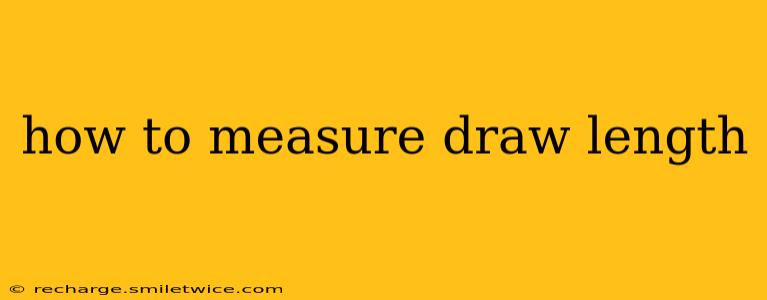Determining your correct draw length is crucial for optimal archery performance, accuracy, and injury prevention. An incorrect draw length can lead to discomfort, poor form, and inconsistent shots. This guide will walk you through various methods to accurately measure your draw length, ensuring you're properly set up for success.
What is Draw Length?
Draw length refers to the distance from the nock point (the point where the bowstring rests on the arrow) to the archer's anchor point (the consistent point on the face or jaw where the archer holds the bowstring during the draw). It's a critical measurement that influences the overall efficiency and accuracy of your shot.
Methods to Measure Draw Length
There are several methods you can use to determine your draw length. Each method has its pros and cons, and the best method for you may depend on your access to equipment and your level of comfort.
1. The Simple Measurement Method (Using a Ruler or Tape Measure)
This method is a quick and easy way to get a general estimate of your draw length, but it's less precise than other methods.
- Find your anchor point: This is the point on your face where your bowstring consistently rests during your draw. Common anchor points include the corner of your mouth, just below your ear, or your jawline. Experiment and find what's most comfortable and consistent for you.
- Extend your arm: Extend your arm fully, mimicking your drawing posture. The string should be where it rests during your anchor.
- Measure: Measure the distance from the string (your fingertip at your anchor point) to where your bowstring would rest on your arrow's nock point (assuming your bow is at your side). This will give you a rough estimate of your draw length.
Pros: Simple and requires minimal equipment. Cons: Not very precise, relies on your ability to accurately mimic your draw posture without a bow.
2. Using a Draw Length Gauge or Tool
Draw length gauges and measuring tools are available from archery retailers. These tools provide a much more accurate measurement. They usually allow you to mimic your draw cycle with your bowstring, providing a precise measurement to where the string would rest on the arrow's nock point.
Pros: More precise than the simple method. Cons: Requires the purchase of a specialized tool.
3. The Ammunition Method
This is a less common method that's only relevant to some types of arrows and it's not a highly recommended method. It involves using arrows of different lengths to try different draw lengths until you find the one most comfortable and consistent with your shooting style.
Pros: Helps adjust the draw length while shooting. Cons: It's time-consuming, and you need numerous arrows to test this. It is inefficient and not recommended compared to other methods.
How to Use Your Measured Draw Length
Once you've determined your draw length, you'll need to use this information to set up your bow properly. This typically involves adjusting the bow's draw stop or modules to match your measured draw length. Consult your bow's manual for specific instructions on how to adjust the draw length. Improper adjustment could damage your bow or compromise safety.
What if My Draw Length Changes?
Your draw length may change slightly over time due to factors such as muscle growth, physical changes, or changes in your shooting form. It's advisable to periodically re-measure your draw length and adjust your bow accordingly to maintain optimal performance and prevent injury.
Frequently Asked Questions (FAQ)
What happens if my draw length is too long or too short?
If your draw length is too long, you may experience shoulder pain, poor accuracy, and inconsistent shots. If it's too short, you may not be able to fully draw the bow, resulting in reduced power and accuracy, along with decreased efficiency in shots.
Can I measure my draw length without a bow?
You can get a rough estimate using the simple measurement method described above, but for a more accurate measurement, using a draw length gauge or tool is recommended.
How often should I re-measure my draw length?
It's a good idea to re-measure your draw length every few months, or more frequently if you notice changes in your body or shooting form.
Does draw length affect arrow spine?
Yes, draw length is a crucial factor in determining the appropriate arrow spine. An incorrect arrow spine can negatively impact accuracy and consistency.
Remember: Always prioritize safety and consult with experienced archers or professionals at your local archery shop for assistance if you're unsure about any aspect of measuring or adjusting your draw length. Accurate draw length measurement is vital for a safe and enjoyable archery experience.
